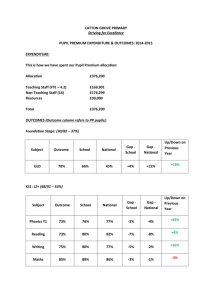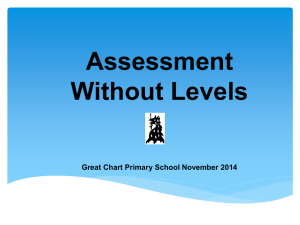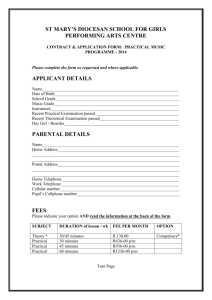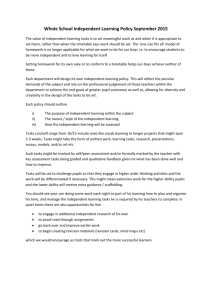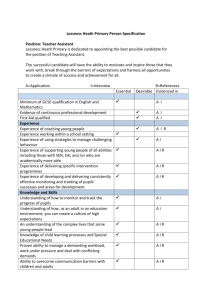20151216150838-St Bons equality-objectives-2015-2018
advertisement
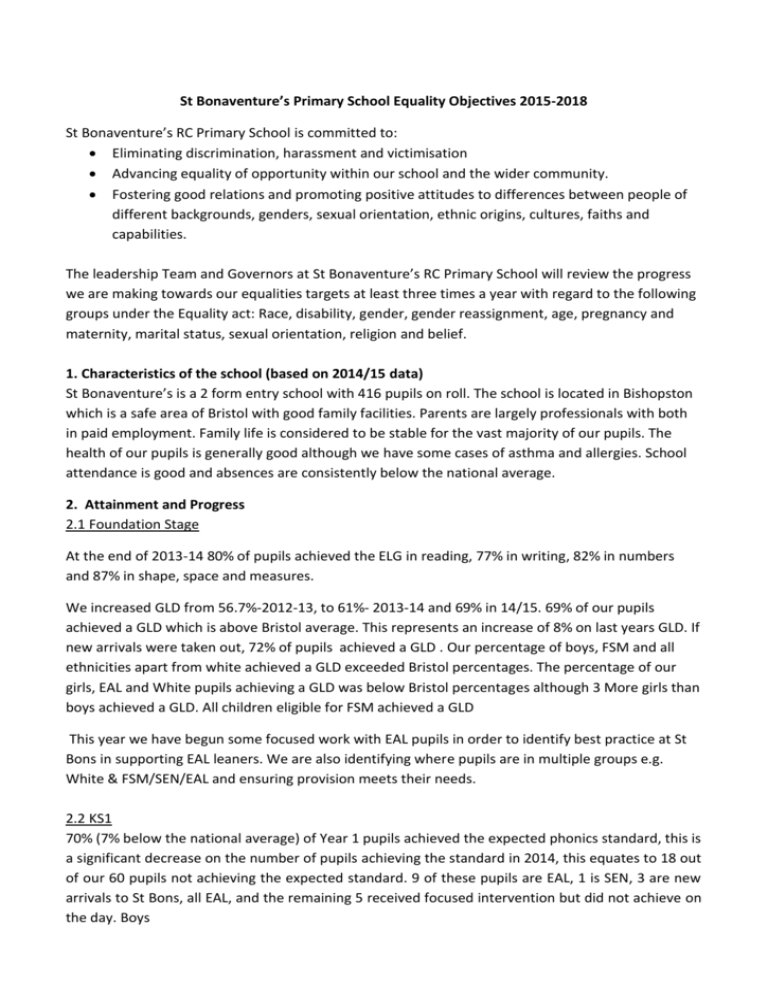
St Bonaventure’s Primary School Equality Objectives 2015-2018 St Bonaventure’s RC Primary School is committed to: Eliminating discrimination, harassment and victimisation Advancing equality of opportunity within our school and the wider community. Fostering good relations and promoting positive attitudes to differences between people of different backgrounds, genders, sexual orientation, ethnic origins, cultures, faiths and capabilities. The leadership Team and Governors at St Bonaventure’s RC Primary School will review the progress we are making towards our equalities targets at least three times a year with regard to the following groups under the Equality act: Race, disability, gender, gender reassignment, age, pregnancy and maternity, marital status, sexual orientation, religion and belief. 1. Characteristics of the school (based on 2014/15 data) St Bonaventure’s is a 2 form entry school with 416 pupils on roll. The school is located in Bishopston which is a safe area of Bristol with good family facilities. Parents are largely professionals with both in paid employment. Family life is considered to be stable for the vast majority of our pupils. The health of our pupils is generally good although we have some cases of asthma and allergies. School attendance is good and absences are consistently below the national average. 2. Attainment and Progress 2.1 Foundation Stage At the end of 2013-14 80% of pupils achieved the ELG in reading, 77% in writing, 82% in numbers and 87% in shape, space and measures. We increased GLD from 56.7%-2012-13, to 61%- 2013-14 and 69% in 14/15. 69% of our pupils achieved a GLD which is above Bristol average. This represents an increase of 8% on last years GLD. If new arrivals were taken out, 72% of pupils achieved a GLD . Our percentage of boys, FSM and all ethnicities apart from white achieved a GLD exceeded Bristol percentages. The percentage of our girls, EAL and White pupils achieving a GLD was below Bristol percentages although 3 More girls than boys achieved a GLD. All children eligible for FSM achieved a GLD This year we have begun some focused work with EAL pupils in order to identify best practice at St Bons in supporting EAL leaners. We are also identifying where pupils are in multiple groups e.g. White & FSM/SEN/EAL and ensuring provision meets their needs. 2.2 KS1 70% (7% below the national average) of Year 1 pupils achieved the expected phonics standard, this is a significant decrease on the number of pupils achieving the standard in 2014, this equates to 18 out of our 60 pupils not achieving the expected standard. 9 of these pupils are EAL, 1 is SEN, 3 are new arrivals to St Bons, all EAL, and the remaining 5 received focused intervention but did not achieve on the day. Boys 3 children resat the screening check in Year 2. One achieved the expected standard and the other children failed to meet the standard. We are consistently above the national average attainment at the end of Key Stage 1. Attainment at the end of 2014-15 was above local and national average levels (APS score for all subjects is significantly above the national trend over 4 years. significantly above in Reading 2C to 3 +, Significantly above in Writing 2C to 2A +, Maths 2B to 3+ from RAISE online 2015). More boys than girls achieved 2A+ in Writing but more girls achieved level 3. We have slightly increased the number of children achieving a level 3 however due to the increased expectation of the Year 2 Maths curriculum we are also focusing on how we use support strategies to accelerate progress and at least meet the year group expectation at the end of Year 2. 2.3 KS2 The combined attainment of Reading, Writing and Maths at the end of 2014-15 is significantly above local and national averages at level 4 which has been the trend over 4 years. However it is in line with local and national averages at level 5. The percentage of pupils achieving two levels progress in Reading, Writing and Maths has dipped compared to previous years. 88% of children made expected progress in Reading and 14% exceeded expected progress. 6 children did not covert from a L3 to L5. 96% of pupils achieved expected progress in Writing and 16% exceeded expected progress. In Maths 82% achieved expected progress with 25% exceeding. The school is addressing the issues through targeted interventions and use of LSAs to provide support for groups and individuals. 3. Gender The proportion of boys and girls in the school is roughly average. At KS1, more girls achieved the highest levels in Writing. More boys than girls achieved 2A+ in Writing but more girls achieved level 3. We have slightly increased the number of children achieving a level 3 however due to the increased expectation of the Year 2 Maths curriculum we are also focusing on how we use support strategies to accelerate progress and at least meet the year group expectation at the end of Year 2. Boys and girls both perform broadly in line or above national expectations by the end of KS2. At KS2, boys outperformed girls in all subjects at Level 4+. Girls outperformed boys at L5 in reading and writing while more boys attained L5 in Maths than girls. 4. Ethnicity and EAL The percentage of pupils from minority ethnic groups increased significantly over past three years by 7.7% with an percentage increased of 4.5% last year. There has been an increase across all ethnic groups(+ irish, +AOWB, +AOMB, +Indian, + AOA, + AOB, + African, + AOEG). Our percentage of pupils with EAL has increased by 7% over three years with an increase of 2.3% in 14/15. English as a first Language has decreased and we are now above the national average for children with EAL. Year 3 has the highest percentage of EAL while Year 3 and 4 have the highest percentage of Minority ethnic groups. We focus carefully on the provision for our growing group of EAL children who are new to the UK without English. These children are tracked as individuals in the class context but also as a group across the school to ensure sufficient scrutiny and to identify potential patterns of underperformance. We have a systematic process for induction and this ensures these children are integrated well into the class. We ensure that we use positive images of ethnically diverse people to raise awareness and reflect of our culturally diverse wider community. We celebrate the languages children speak and celebrate Black History Month. The school has set up a coffee morning for EAL parents. The aim of this was to provide a secure environment for parents to meet each other, share their experiences and prevent isolation. This has been developed this year with visits from staff members to talk about the school website, homework, reading, the English curriculum and the math curriculum. 5. Religion and Belief Our school is a Catholic school and the majority of our pupils come from Christian families or families who want a Christian education for their children. The school values the diversity of our community and recognises the wide range of members of faith groups as well as those who have no religion. Our whole school events reflect this with active participation of our wider community in celebrating special days and festivals eg Diwali, Eid, Easter and Christmas. Our RE and PSHE curriculum contributes to elimination of discrimination, harassment and victimisation and promotion of equality of opportunity. The curriculum is assessed and monitored carefully to ensure these values are modelled and so that our learners are sufficiently prepared for modern society. 6. Economic status The proportion of children receiving pupil premium is currently 8%. Which is lower than the national average. The current Year 5 and 6 have highest percentage of FSM. At the end of KS1, all children achieved or exceeded the ARE (Age Related Expectations). At KS2, 83% achieved the ARE in Reading, 58% achieved the ARE in writing and 67% achieved the ARE in Maths. These results are lower than last year but the majority of pupils in this group (7/12) joined the school in KS2. The school is looking into how we can raise the attainment of pupil premium children this year. 7. Disability / Long term medical condition We currently have five children with a physical disability. We have in place accessible toilets and shower facilities as well as a lift. We are currently in the process of buying a changing table for a pupil who is still in nappies. Currently, physical disabilities have not affected progress and attainment although we will continue to monitor these children. 8. Special Educational Needs We have a range of SEN at St Bon’s with 4 children currently on a statement or EHCP. Due to the changes in the SEN Code of Practice, the amount of children on the SEN register has decreased. The SENCO continues to track and monitor those children who are underachieving but not considered to be SEN Support. SLT and class teachers analyse the performance of children with SEN along with all children at least three times yearly and the SENCO ensures rigorous scrutiny of SEN groups and reports to governors six times across the school year. The highest percentage of children with SEN are currently in years 4 and 6. SEN pupil’s achievement and progress is significantly below class average in maths and writing. The school is currently evaluating what intervention programmes are being used and their effectiveness. 8. Sexual Orientation We currently have no pupils identified as having sexual orientation identified as other than heterosexual. However we are committed to eliminating discrimination, harassment and victimisation and advancing equality of opportunity (see anti bullying and harassment policy). We have annual whole school focus weeks on anti-bullying and anti-harassment. We also ensure advancement of equality of opportunity through ensuring positive images are used in assembly and within the curriculum. We have had no incidents of homophobia but we have a system to report all incidents of homophobia to the local authority if any arise and the governors would take positive steps to deal with any issues as outlined in our behaviour policy. Based on the analysis above we have identified the following objectives as key areas for development. Equality Objectives to be seen in conjunction with the Access Plan Element Attainment and Progress Objectives 1. To increase the number of EAL children achieving a GLD by working on speaking and listening activities Data set used Target Tracker Raise Online LA Data pack Person responsible Teachers SENCO/ Inclusion Lead Deputy Head English/ Maths Lead Target Tracker Raise Online LA Data pack Teachers Deputy Head English/ Maths Lead 2. To further raise the attainment and progress of children entitled to Pupil Premium in KS2 in reading, writing and maths and ensure that they achieve outstanding progress throughout the school. 3. To close the gap between boys and girls so that they are in line at the higher levels. Teaching and Learning 1. Teachers know their children’s data (PP, EAL, Ethnic group, SEN) 2. To ensure that classrooms are a language rich environment modelling good use of English and sentence structure. 3. To support parents with Review 2015-16 Review 2016-17 Review 2017-18 homework (accessing online homework) 4. Teachers and LSAs use appropriate language and questioning to support EAL learners Attitudes and belief 5. Teachers use group teaching rather than whole class teaching to address the needs of their classes 1. To create a growth mindset environment 2. To encourage high aspirations for SEN and Pupil Premium pupils 3. Use of displays and assemblies to promote diversity and positive images of women and ethnic groups. 4. Teaching staff throughout the school will work with pupils to develop their resilience and writing stamina in order to make further progress. 5. Attendance at school clubs to be audited to ensure that they contain a good balance of boys and girls, EAL, SEN, ethnic School council Pupil conferencing Teachers School leaders groups. A plan will then be drawn up to redress any imbalance 6. School council to be consulted on how they think the school playground should be used and a plan to be put into place to provide children with alternative things to play with on the playground so that boys are not only playing football. Eg musical instruments Leadership and Management 1. To continue to monitor and analyse the attainment and achievement of vulnerable groups. 2.To continue to develop the EAL coffee mornings to address the needs of EAL families 3. To allocate appropriate resources for Pupil Premium and SEN. 4. To analyse the impact of interventions on vulnerable groups. Target Tracker Raise Online Parent conferencing
